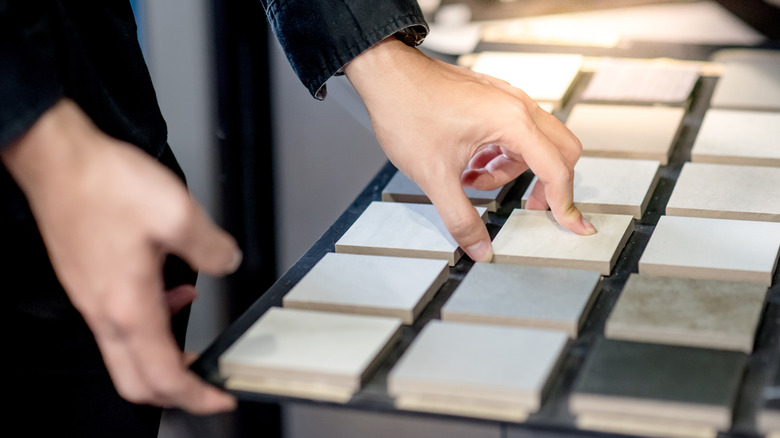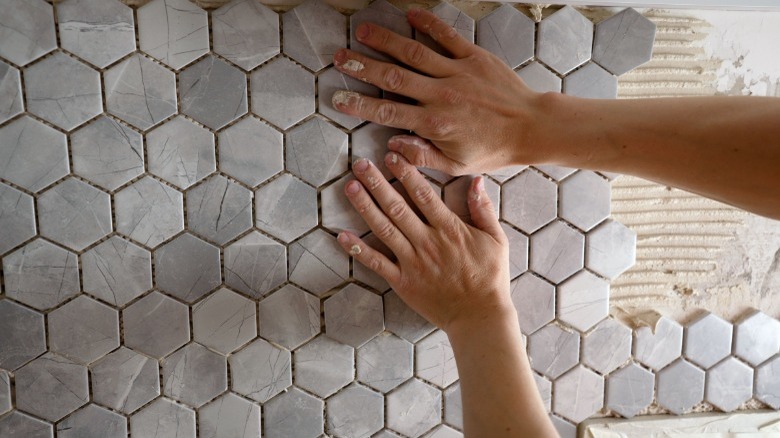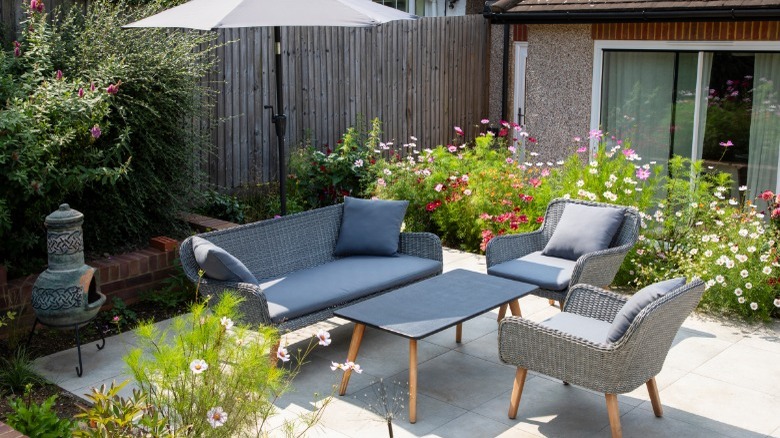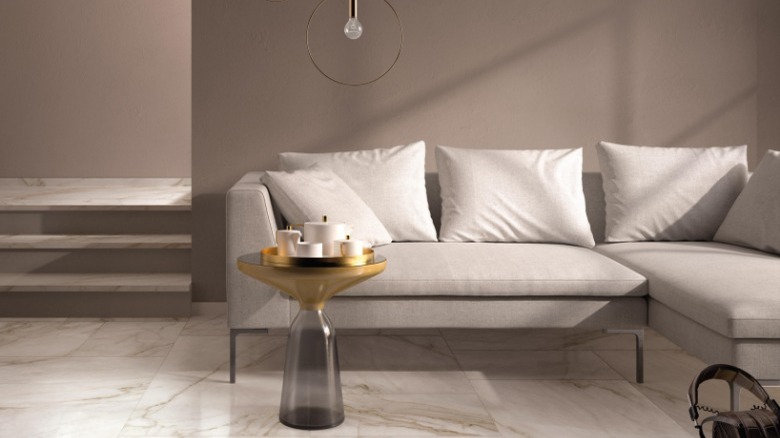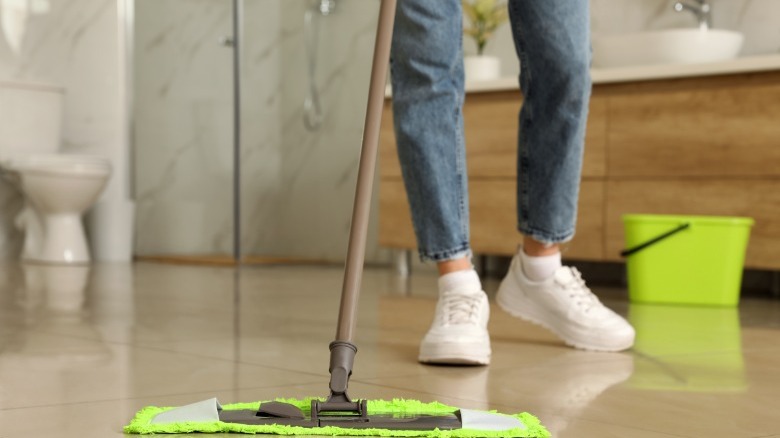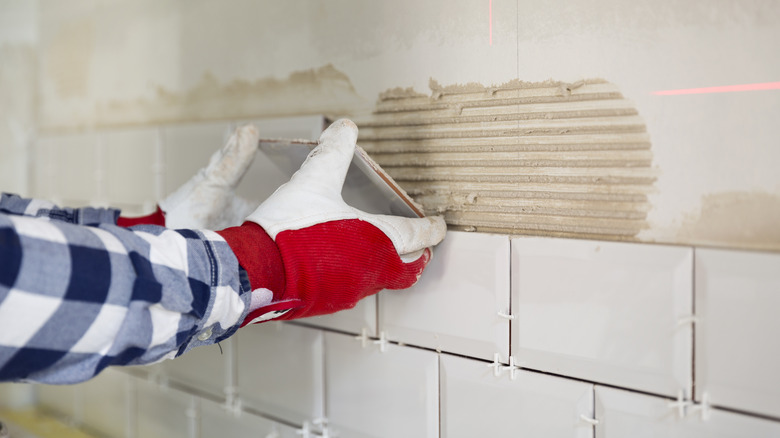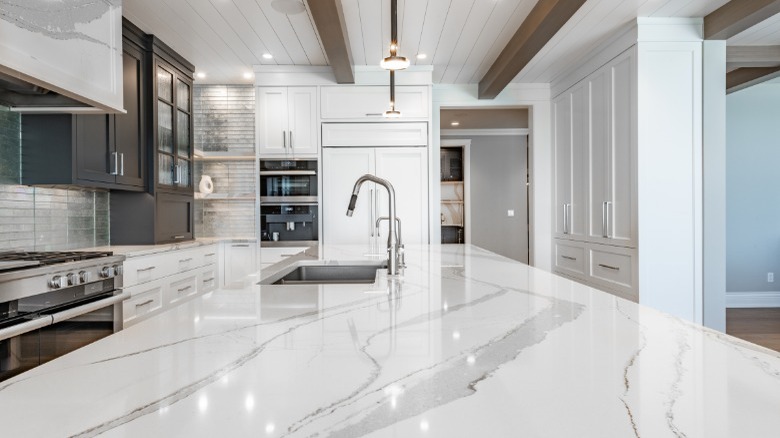What's The Difference? Porcelain Vs. Ceramic Tile
Tile can go on countertops, bathroom walls, kitchen backsplashes, and floors of all kinds. It can be installed indoors or outdoors, and even in swimming pools. Putting in tiles is an investment that adds value to your home, but not all tiles are created equally. Most people choose between porcelain and ceramic, and at first glance, they look deceptively similar. But a few key differences might make one better for your project than the other.
It all depends on what room you're remodeling and what your requirements are. Porcelain is said to be more durable, so it will be better for high-traffic areas like entryways and bathrooms, as well as outdoor spaces like patios and kitchens. However, ceramic comes in more colors and designs, perfect for those creating a statement bathroom or an aesthetic kitchen backsplash. Not sure which is best for your DIY? Here is the difference between ceramic and porcelain.
Difference in how they're manufactured
Both ceramic and porcelain tiles are made from clay, but their ingredients differ. Ceramic tile is created from colored clay mixed with other ingredients such as quartz, talc, or sand. Because of the different ingredients, it comes in many colors and intricate designs. It achieves its strength and durability through high temperatures and intense pressure. The pressure equals about 100,000 pounds per square inch! However, it is softer and less dense than the clay used to make porcelain tiles, making the finished product more porous and, thus, more absorbent.
According to Flooring America, porcelain tile is created with very fine white clay at extremely high temperatures of around 2,300 to 2,400 degrees Fahrenheit. It is baked for a longer period of time than ceramic. The longer, hotter firing process makes it denser and more durable. It also makes it less porous, so porcelain tile is more water and moisture-resistant than ceramic. It can withstand the elements such as heavy rain, snow, and ice, and because of this, it's often chosen for outdoor applications. For instance, outdoor kitchens, patios, and even swimming pools are great choices for porcelain tile. It can also withstand moisture and humidity indoors, so it's a top pick for bathrooms, kitchens, and laundry rooms. That's not to say you can't use ceramic in these rooms; porcelain will just fair better over time.
Pros and cons of porcelain tile
There are multiple pros and cons of porcelain tile flooring, per Express Flooring. The first advantage is its resistance to wear and tear over time. Due to the difference in how it's made, porcelain has more density and hardness than ceramic tile. It chips, crumbles, and wears less, and it is better at withstanding pet and foot traffic. It is also the easiest type of tile to maintain and care for. It doesn't need to be sealed, and you don't need to take extra precautions when washing or wiping it down.
However, porcelain is more difficult to install, cut, and work with. For these reasons, it can be more expensive to install by professionals and more challenging for DIYers. Because it's heavier than ceramic, it's best to work with a contractor who understands the load-bearing capacity of your home's floors, especially if you want to install it upstairs. Additionally, porcelain tile is not available in extensive colors or patterns, while ceramic has a wide variety. They are generally more expensive overall, but their quality is unsurpassed.
Pros and cons of ceramic tile
As with porcelain, ceramic tile also has its pluses and minuses. According to Ocotillo Floors, there are both glazed and unglazed tiles, and glazed ceramic tiles are great for kitchens or high-moisture rooms due to their water resistance. Unglazed tiles can also be used, but in this case, you'll have to seal the tiles for the same protection. Ceramic tiles are less expensive than porcelain, aren't as heavy, and come in more designs, available in unlimited colors and patterns. They're the obvious choice if you want to create a bold design.
As for cons, putting in ceramic tiles is not advised as a DIY project, mainly because if not done correctly, it's prone to mold damage from water seepage due to its porous nature. Because of that, it's also not a great choice for outdoor use like patios or outdoor bars. Plus, it's more prone to crack in cold weather.
Differences in cost
There is a cost difference between the two tile options. According to Angi, glazed ceramic tiles average between $4 to $15 per square foot, not including installation. The overall estimate to install ceramic tile is $1,850, but it can cost up to $5,000. Clearly, there's more than just the cost of materials to consider. Additionally, you'll pay for removing the old floor, unless you do it yourself.
For porcelain tile, Fixr estimates the cost to install porcelain tile as between $2,000 and $4,400, but can run up to $7,000 on the high end. For the porcelain tiles alone, the price ranges from $2 to $30 per square foot.
There are many things that can influence the cost, including square footage, glazed or unglazed (for both types), size of the individual tiles, whether you want them arranged in a specific pattern, and removal of the old flooring. You might also need a new subfloor if your existing one is damaged, which will also increase costs.
Differences in care and maintenance
There is also a difference in how you care for the two different tiles. According to Daltile, routine care of glazed ceramic tiles consists of multiple steps. First, you need to use a low-VOC (volatile organic compound) all-purpose cleaner that is also safe to use on grout. Harsh chemicals and acids can damage the tile and the grout, and ammonia will discolor the grout. On floors, you have to use a cotton mop, and then switch to a non-metallic brush for scrubbing. It's important to vacuum or sweep before wet cleaning, and rinse and dry completely afterward.
Routine cleaning for porcelain tile consists simply of using a mild detergent and warm water (via Daltile). Be sure always to dry your tile floors afterward. Neither glazed type of tile needs to be sealed, but the grout and joints should be sealed for both types. Porcelain tile absorbs almost no water, but ceramic tile is more porous.
Differences in installation or DIY process
The process of installation for both ceramic and porcelain tiles is nearly identical. The main difference is the difficulty in cutting the tiles. Porcelain tile is much harder to cut than ceramic. According to Rubi, you'll need a special porcelain tile cutter, and even with this tool, the layers of the porcelain can easily chip or break. It's advised to use a wet saw and a diamond blade for cutting them. This is due to its density and hardness over ceramic.
For ceramic tiles, use a glass cutter or a tile nipper for small jobs. An angled grinder can also be used for bigger jobs and varying cuts, but ceramic tile is not as difficult to cut without breakage (via Tile Club). As we've already gone over, neither is recommended as a DIY project, but it can be done. If you're trying to save a little money and have some experience laying tile, you can probably accomplish it. But keep in mind that when tile is laid incorrectly, it can create trip hazards if not leveled properly or create mold growth if not sealed correctly. Between the two, ceramic tile is an easier DIY project for these reasons.
Differences in real estate value/ROI
Believe it or not, according to Realtor.com, there is a higher return on investment for ceramic tile over porcelain. Its estimate for ceramic tile is $12 to $25 per square foot, with an estimated ROI of at least 70%. If you are qualified to do the project yourself, the ROI can even exceed 100%, due to the labor-intensive costs.
The estimate for porcelain tile is $18 to $32 per square foot, with an average ROI of 55%. Unfortunately, this is due to the cost of materials and professional installation. This is why it lowers the return on your investment.
But when selling your house, educated buyers prefer porcelain due to its durability, stain resistance, and water absorption. Both varieties will increase the home value, but informed buyers are particularly impressed by porcelain. However, if you want more bang for your buck and are flipping the bathroom or kitchen before you sell it, ceramic might be your best bet.
Durability differences
According to Home Inspection Insider, ceramic and porcelain tiles have an overall life expectancy of 75 to 100 years. This is great news for homeowners looking into either choice, but there are differences between the two regarding durability factors. Because porcelain tile is created with finer clay and at higher temperatures, the final product is harder and denser than ceramic. It is, therefore, more resistant to water, stains, scratches, etc. than ceramic.
However, ceramic is also considered highly durable and resistant to scratches, dents, and abrasions. Porcelain tile is more suitable for wet applications such as kitchens, bathrooms, patios, and even swimming pools. Ceramic tile is ideal for large areas of the house, and because it's more affordable than porcelain, it also makes a good choice for areas that don't get a lot of moisture. Either option is going to give you long-lasting durability and a beautiful look. Just choose a professional contractor for the installation process for the best results and resale value of your home.
